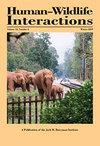棕头牛鹂的管理:对濒危物种和减轻农业损害的影响
IF 0.9
4区 环境科学与生态学
Q4 BIODIVERSITY CONSERVATION
引用次数: 6
摘要
褐头牛鹂(Molothrus ater;牛鹂)在北美黑鹂(黄鹂科)中是独一无二的,因为它可以减轻对濒危鸣禽的负面影响和农业作物的经济损失。牛椋鸟的幼虫寄生会进一步影响由于人为土地利用而被认为受到威胁或濒临灭绝的物种。从历史上看,牛郎鸟经常在没有解决鸣鸟数量下降的最终原因的情况下被捕杀。与其他北美黑鸟类似,牛鹂也会破坏农作物,尽管其他黑鸟的比例较低。关于牛郎鸟对农业造成的损害程度和用于管理的缓解措施的有效性,存在相互矛盾的信息。本文综述了2005年至2020年我国在濒危物种方面所取得的进展。我们还回顾了牛椋鸟对水稻(Oryza sativa)作物造成的损失以及旨在减少掠夺的计划。在四种被管理的鸣禽中,由于栖息地的扩张导致种群数量增加,柯特兰莺(kirtlanddii)和黑冠灰莺(vireo atricapilla)都已从濒危物种名单中删除。对牛郎鸟的诱捕已经停止,但对牛郎鸟的诱捕仍在继续。相比之下,最小贝尔氏病毒(V. bellii pusillus)和西南柳捕蝇(emidonax traillii extimus)在适当的栖息地适度增加后仍然需要控制。我们对牛椋鸟对水稻的掠夺进行了回顾,发现用来确定牛椋鸟数量以减少水稻损失的模型是有用的,但需要结合水稻种植区牛椋鸟种群变化、饮食偏好研究以及种群性别比例和雌性牛椋鸟产卵的最新信息来改进新数据。一旦收集到这些信息,生物能源和经济模型将增加我们对牛郎鸟造成的损害的理解。本文章由计算机程序翻译,如有差异,请以英文原文为准。
Management of the Brown-Headed Cowbird: Implications for Endangered Species and Agricultural Damage Mitigation
The brown-headed cowbird (Molothrus ater; cowbird) is unique among North American blackbirds (Icteridae) because it is managed to mitigate the negative effects on endangered songbirds and economic losses in agricultural crops. Cowbird brood parasitism can further affect species that are considered threatened or endangered due to anthropogenic land uses. Historically, cowbirds have often been culled without addressing ultimate causes of songbird population declines. Similar to other North American blackbirds, cowbirds depredate agricultural crops, albeit at a lower rate reported for other blackbird species. Conflicting information exists on the extent of agricultural damage caused by cowbirds and the effectiveness of mitigation measures for application to management. In this paper, we reviewed the progress that has been made in cowbird management from approximately 2005 to 2020 in relation to endangered species. We also reviewed losses to the rice (Oryza sativa) crop attributed to cowbirds and the programs designed to reduce depredation. Of the 4 songbird species in which cowbirds have been managed, both the Kirtland’s warbler (Dendroica kirtlandii) and black-capped vireo (Vireo atricapilla) have been removed from the endangered species list following population increases in response to habitat expansion. Cowbird trapping has ceased for Kirtland’s warbler but continues for the vireo. In contrast, least Bell’s vireo (V. bellii pusillus) and southwestern willow flycatcher (Empidonax traillii extimus) still require cowbird control after modest increases in suitable habitat. Our review of rice depredation by cowbirds revealed models that have been created to determine the number of cowbirds that can be taken to decrease rice loss have been useful but require refinement with new data that incorporate cowbird population changes in the rice growing region, dietary preference studies, and current information on population sex ratios and female cowbird egg laying. Once this information has been gathered, bioenergetic and economic models would increase our understanding of the damage caused by cowbirds.
求助全文
通过发布文献求助,成功后即可免费获取论文全文。
去求助
来源期刊

Human–Wildlife Interactions
Environmental Science-Nature and Landscape Conservation
CiteScore
2.80
自引率
0.00%
发文量
0
审稿时长
11 weeks
期刊介绍:
Human–Wildlife Interactions (HWI) serves the professional needs of the wildlife biologist and manager in the arena of human–wildlife conflicts/interactions, wildlife damage management, and contemporary wildlife management. The intent of HWI is to publish original contributions on all aspects of contemporary wildlife management and human–wildlife interactions with an emphasis on scientific research and management case studies that identify and report innovative conservation strategies, technologies, tools, and partnerships that can enhance human–wildlife interactions by mitigating human–wildlife conflicts through direct and indirect management of wildlife and increased stakeholder engagement. Our intent is to promote a dialogue among wildlife professionals concerning contemporary management issues. As such, we hope to provide a repository for wildlife management science and case studies that document and share manager experiences and lessons learned.
 求助内容:
求助内容: 应助结果提醒方式:
应助结果提醒方式:


